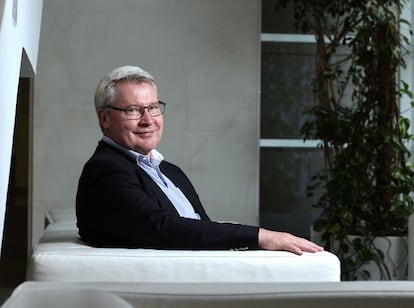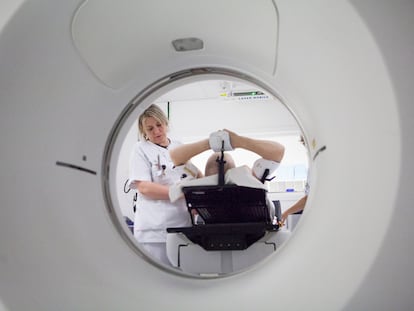Klaus Pantel, oncologist: ‘With blood tests, we can find signs of the tumor returning months before the radiologist can see it’
The director of the Institute of Tumor Biology in Hamburg, Germany talks about the possibilities of liquid biopsies to detect cancer in early stages, or to know if someone is truly cured after surgery

Klaus Pantel, 63, began chasing migrating cancer cells through the bloodstream three decades ago. After years of work, the German oncologist was able to identify that patients with a high number of those cells died earlier than others. And, in 2010 — together with Catherine Alix-Panabières, from the Montpellier University Hospital Center in France — they wrote an article, in which they explained the potential of detecting tumor cells in blood for early tumor discovery and monitoring. This is when the term “liquid biopsy” was coined — the idea that, with a blood test, without having to extract cancerous tissue from the patient, it would be possible to know if they had the disease.
“The term was adapted very quickly to talk about the detection of products circulating in the blood, from tumor cells to circulating DNA. We had no idea that it was going to be so popular,” acknowledges Pantel, director of the Institute of Tumor Biology in Hamburg, Germany. Today, a liquid biopsy is one of the most promising tools to detect cancer when it’s still treatable, to design personalized therapies, or to evaluate whether a treatment is working or if it should be changed.
Question. How did you come up with the idea of doing a liquid biopsy?
Answer. We were thinking about getting as much information from a cancer patient’s blood as possible. Usually, to obtain information about a tumor, you take a syringe and puncture the tumor tissue. That’s a tissue biopsy. We thought we could do that with blood. And, because we thought “blood biopsy” didn’t sound [good], we called it “liquid biopsy.”
Q. Is the name important for a medical procedure to be considered acceptable?
A. The name is very important. There were other groups that proposed different names… but this one survived.
Q. What are the obstacles that liquid biopsies still face on the path to becoming commonly-used diagnostic methods?
A. The challenge right now is to take [the procedure] from research to clinical practice. To achieve this, we need to ensure that the blood tests we use are robust [and that they work properly]. They need to work the same on a Monday as they do on a Friday, so that we can standardize the technology. It’s also important that we develop the appropriate tests for each clinical question. For example, if you want to detect pancreatic cancer early, you need very sensitive tests to detect the tumor when it’s small and there are very few molecules in the blood. But, if you have a tumor in the metastatic phase, [when the disease has advanced], there are more molecules in the blood and you can do another type of analysis. And you also have to choose which patients can benefit from each type of test and make it available to doctors. There’s a mix of clinical validation and technology involved, [along with] the education of specialists.
For now, liquid biopsies are most useful for tracking how treatment is progressing, because it’s a painless test that you can do — if necessary — every day. This way, you can see if an individual is responding to a therapy, if the tumor burden is going up or down, or if the cancer is developing resistance to treatment. The tests also tell us the molecular characteristics of the tumor and [help us determine] which therapy may be most appropriate.
Q. Can these types of tests replace some of the current screening systems?
A. [Liquid biopsies] can be used to screen for lung cancer or pancreatic cancer, which are often detected when it’s too late and the tumor is too large. [Early detection] would be a big help to patients, because surgeons could remove the tumor while it’s still small. Another project that [we’re now doing] tries to follow up after the tumor has been removed. At that point, you may think you’re safe… but tumor cells may continue to spread, even though the radiologist can’t see them. The question that all patients have is: “Will my tumor come back, or am I cured?” With these blood tests, we can find signs of the tumor returning months before the radiologist can see it. And, [if this is possible in the future], we could [resume] treatments sooner.
Q. What would those very early treatments be like? Could they involve something like a blood pressure pill, to keep those tumor cells circulating in the blood at bay?
A. Yes, the best [option] would be a pill, because it’s easy to take. Ideally, it wouldn’t have many side effects, so that it can be taken as [a preventative measure], eliminating those tumor cells from the blood or keeping them at very low levels. The question now is what kind of medication could help stop the disease at this early stage.
Q. Early detection also comes with the risks of overdiagnosis, or failing to reduce cancer deaths. We’ve seen this with mammograms.
A. If you use this technology to detect tumors, you have to make sure [that the circulating material in the bloodstream] is really from a tumor, because if it’s not, you’ll drive patients crazy. The tests have to be very precise, otherwise you can terrify people.
Q. Is there any type of tumor in which a liquid biopsy is more promising?
A. The most common [types of cancer detected by liquid biopsies] are breast, colon and lung cancer, but [they can also help with the detection of] aggressive tumors, in the pancreas or ovaries. These cancers are always detected too late. There’s a great medical need there.
Q. Is a liquid biopsy also of interest as a research tool, to understand how tumor cells travel through the body and jump from one organ to another?
A. I’ve been working on tumor cell metastasis for more than 30 years. We’ve seen that these cells spread throughout the body at a very early stage of tumor development. In the past, we thought that the tumor had to be large to spread… but not all the cells that travel necessarily grow. Some can be silent for more than ten years, such as breast cancer. The body can control the spread of cancer during all that time, but the [big question] is why that control system stops working. In breast cancer, you can have relapses after 15 years. Understanding how the body controls tumor cells is very important, because this knowledge could be used in new treatments.
Sign up for our weekly newsletter to get more English-language news coverage from EL PAÍS USA Edition
Tu suscripción se está usando en otro dispositivo
¿Quieres añadir otro usuario a tu suscripción?
Si continúas leyendo en este dispositivo, no se podrá leer en el otro.
FlechaTu suscripción se está usando en otro dispositivo y solo puedes acceder a EL PAÍS desde un dispositivo a la vez.
Si quieres compartir tu cuenta, cambia tu suscripción a la modalidad Premium, así podrás añadir otro usuario. Cada uno accederá con su propia cuenta de email, lo que os permitirá personalizar vuestra experiencia en EL PAÍS.
¿Tienes una suscripción de empresa? Accede aquí para contratar más cuentas.
En el caso de no saber quién está usando tu cuenta, te recomendamos cambiar tu contraseña aquí.
Si decides continuar compartiendo tu cuenta, este mensaje se mostrará en tu dispositivo y en el de la otra persona que está usando tu cuenta de forma indefinida, afectando a tu experiencia de lectura. Puedes consultar aquí los términos y condiciones de la suscripción digital.
More information
Archived In
Últimas noticias
The life of a delivery driver in China: ‘Many people don’t know how an order can arrive at their home in just one day’
Maude Apatow, from acting in ‘Euphoria’ to directing: ‘There are many films that you can tell weren’t written by someone young’
Mexico’s missing people crisis casts a shadow over World Cup venue
Helen Levitt, the photographer who captured the theater of the everyday
Most viewed
- Christian Louboutin: ‘Young people don’t want to be like their parents. And if their parents wear sneakers, they’re going to look for something else’
- US sanctions against jailed cartel leader ‘El Marro’ highlight Mexico’s lack of control over its prisons
- Cartels in Mexico take a leap forward with narco-drones: ‘It is criminal groups that are leading the innovation race’
- Liset Menéndez de la Prida, neuroscientist: ‘It’s not normal to constantly seek pleasure; it’s important to be bored, to be calm’
- ‘El Limones’ and the growing union disguise of Mexican organized crime










































